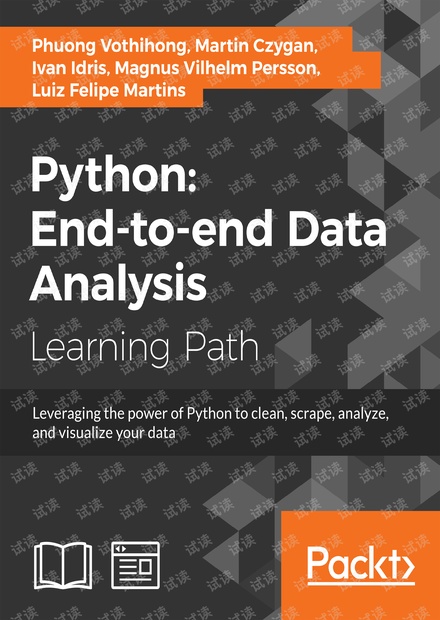没有合适的资源?快使用搜索试试~ 我知道了~
首页Python End-to-end Data Analysis 无水印pdf
Python End-to-end Data Analysis 无水印pdf
Python End-to-end Data Analysis 英文无水印pdf pdf所有页面使用FoxitReader和PDF-XChangeViewer测试都可以打开 本资源转载自网络,如有侵权,请联系上传者或csdn删除 本资源转载自网络,如有侵权,请联系上传者或csdn删除
资源详情
资源评论
资源推荐


Python: End-to-end
Data Analysis
Leverage the power of Python to clean, scrape,
analyze, and visualize your data
A course in three modules
BIRMINGHAM - MUMBAI

Python: End-to-end Data Analysis
Copyright © 2016 Packt Publishing
All rights reserved. No part of this course may be reproduced, stored in a retrieval
system, or transmitted in any form or by any means, without the prior written
permission of the publisher, except in the case of brief quotations embedded in
critical articles or reviews.
Every effort has been made in the preparation of this course to ensure the accuracy
of the information presented. However, the information contained in this course
is sold without warranty, either express or implied. Neither the authors, nor Packt
Publishing, and its dealers and distributors will be held liable for any damages
caused or alleged to be caused directly or indirectly by this course.
Packt Publishing has endeavored to provide trademark information about all of the
companies and products mentioned in this course by the appropriate use of capitals.
However, Packt Publishing cannot guarantee the accuracy of this information.
Published on: May 2017
Production reference: 1050517
Published by Packt Publishing Ltd.
Livery Place
35 Livery Street
Birmingham B3 2PB, UK.
ISBN 978-1-78839-469-7
www.packtpub.com

Credits
Authors
Phuong Vo.T.H
Martin Czygan
Ivan Idris
Magnus VilhelmPersson
Luiz Felipe Martins
Reviewers
Dong Chao
Hai Minh Nguyen
Kenneth Emeka Odoh
Bill Chambers
Alexey Grigorev
Dr. VahidMirjalili
Michele Usuelli
Hang (Harvey) Yu
Laurie Lugrin
Chris Morgan
Michele Pratusevich
Content Development Editor
Aishwarya Pandere
Graphics
Jason Monteiro
Production Coordinator
Deepika Naik

[ i ]
Preface
The use of Python for data analysis and visualization has only increased in
popularity in the
last few years.
The aim of this book is to develop skills to effectively approach almost any data
analysis problem, and extract all of the available information. This is done by
introducing a range of varying techniques and methods such as uni- and multi-
variate linear regression, cluster finding, Bayesian analysis, machine learning, and
time series analysis. Exploratory data analysis is a key aspect to get a sense of what
can be done and to maximize the insights that are gained from the data. Additionally,
emphasis is put on presentation-ready figures that are clear and easy to interpret.
What this learning path covers
Module 1, Getting Started with Python Data Analysis, shows how to work with time-
oriented data in Pandas. How do you clean, inspect, reshape, merge, or group data
– these are the concerns in this chapter. The library of choice in the course will be
Pandas again.
Module 2, Python Data Analysis Cookbook, demonstrates how to visualize
data and mentions frequently encountered pitfalls. Also, discusses
statistical probability distributions and correlation between two variables.
Module 3, Mastering Python Data Analysis, introduces linear, multiple, and logistic
regression with in-depth examples of using SciPy and stats models packages to test
various hypotheses of relationships between variables.
剩余910页未读,继续阅读
yinkaisheng-nj
- 粉丝: 763
- 资源: 6953
上传资源 快速赚钱
 我的内容管理
收起
我的内容管理
收起
 我的资源
快来上传第一个资源
我的资源
快来上传第一个资源
 我的收益 登录查看自己的收益
我的收益 登录查看自己的收益 我的积分
登录查看自己的积分
我的积分
登录查看自己的积分
 我的C币
登录后查看C币余额
我的C币
登录后查看C币余额
 我的收藏
我的收藏  我的下载
我的下载  下载帮助
下载帮助

会员权益专享
最新资源
- 27页智慧街道信息化建设综合解决方案.pptx
- 计算机二级Ms-Office选择题汇总.doc
- 单链表的插入和删除实验报告 (2).docx
- 单链表的插入和删除实验报告.pdf
- 物联网智能终端项目设备管理方案.pdf
- 如何打造品牌的模式.doc
- 样式控制与页面布局.pdf
- 武汉理工Java实验报告(二).docx
- 2021线上新品消费趋势报告.pdf
- 第3章 Matlab中的矩阵及其运算.docx
- 基于Web的人力资源管理系统的必要性和可行性.doc
- 基于一阶倒立摆的matlab仿真实验.doc
- 速运公司物流管理模式研究教材
- 大数据与管理.pptx
- 单片机课程设计之步进电机.doc
- 大数据与数据挖掘.pptx
资源上传下载、课程学习等过程中有任何疑问或建议,欢迎提出宝贵意见哦~我们会及时处理!
点击此处反馈



安全验证
文档复制为VIP权益,开通VIP直接复制
 信息提交成功
信息提交成功
评论1